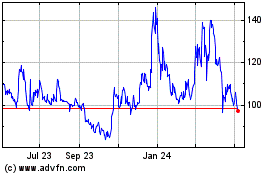Will QE Drive Bitcoin And Crypto To New All-Time Highs? Fidelity Exec Is Cautious
23 March 2023 - 1:25AM
NEWSBTC
In the Bitcoin and crypto community, there has been plenty of talk
in recent days that the US Federal Reserve (Fed) has fired up its
money printer again with the Bank Term Funding Program (BTFP) and
swap lines for five other central banks around the world,
effectively kicking off Quantitative Easing (QE). Generally, QE is
considered one of the most bullish drivers for the Bitcoin price,
but the one million dollar question is whether the Fed has actually
started QE yet? Is QE Just Around The Corner? Jurrien Timmer,
Director of Global Macro at Fidelity Investments, takes a different
view than the broader market on this. In a Twitter thread, Timmer
wrote that a return to QE is probably not yet imminent. Are we
about to see a return to QE? Probably not yet. It’s worth
remembering last fall, when the Bank of England (BoE) conducted
temporary asset purchases to solve for an asset-liability mismatch
similar to what we are seeing in the US now. 🧵
pic.twitter.com/bpafYjmo0A — Jurrien Timmer (@TimmerFidelity) March
21, 2023 “It’s worth remembering last fall, when the Bank of
England (BoE) conducted temporary asset purchases to solve for an
asset-liability mismatch similar to what we are seeing in the US
now,” the exec at one of the world’s largest asset managers said.
As Timmer discusses, the BoE insisted that its temporary gilt
purchases were not quantitative easing (QE), and in hindsight, it
was right. In total, the bank bought £19.3 billion worth of gilts,
of which £12.1 billion were long-dated conventional gilts and £7.2
billion were index-linked gilts. The purchases were indeed
temporary, according to a January 2023 BoE press release. Related
Reading: Bitcoin To $1 Million? Why Hyperinflation Is Unlikely In
The US The bank sold all of its portfolio of temporarily held
government bonds after the crisis passed and quantitative
tightening (QT) continued, as did interest rate hikes. “Fast
forward to today, and we could view last week’s sharp increase in
the Fed’s balance sheet as a similar exercise in liquidity
provision,” Timmer asserts. Moreover, he says, a look back to the
global financial crisis in 2008 is helpful in classifying the Fed’s
moves. Before the Fed began QE in March 2009, it conducted
liquidity operations such as Term Asset-Backed Securities Loan
Facility (TALF) in late 2008. “Those programs temporarily boosted
the Fed’s balance sheet but were merely liquidity bridges
(collateralized loans), although QE did soon follow. Perhaps the
BTFP will be the same;” Timmer pointed out, but also noted that
interest rates are running high enough to cause pain to the banking
system. Related Reading: Bitcoin Price Stalls Ahead Of FOMC
Meeting, How To Trade It Therefore, to combat inflation while
keeping the banking system alive, Timmer suggests that the Fed
could try to keep long-term interest rates low by managing the
yield curve. The Fed did that during the second half of the 1940s,
even as it was raising rates (ever so slightly) and shrinking the
balance sheet. So perhaps we should be on the lookout for changes
in the Fed’s maturity distribution. What Does This Mean For
Bitcoin? For Bitcoin and crypto investors, this means that they
should not be blinded by the current exuberant euphoria. Today’s
Fed rate decision and, more importantly, future projections (dot
plot) and statements from Fed Chairman Jerome Powell will be quite
crucial in determining whether QE is really around the corner or
still a few months away, as Timmer cautions. At press time, Bitcoin
was trading at $28.287, just below the current key resistance zone.
A breakout could trigger a move towards $30,000, while a dampener
from the Fed could trigger a dip back to $27,000. Featured image
from iStock, chart from TradingView.com
Quant (COIN:QNTUSD)
Historical Stock Chart
From Mar 2024 to Apr 2024

Quant (COIN:QNTUSD)
Historical Stock Chart
From Apr 2023 to Apr 2024
